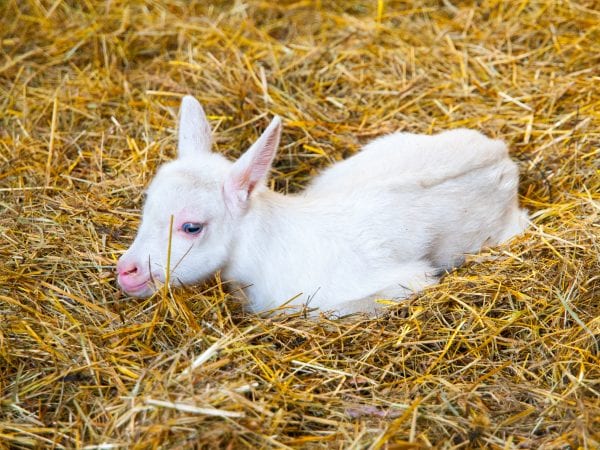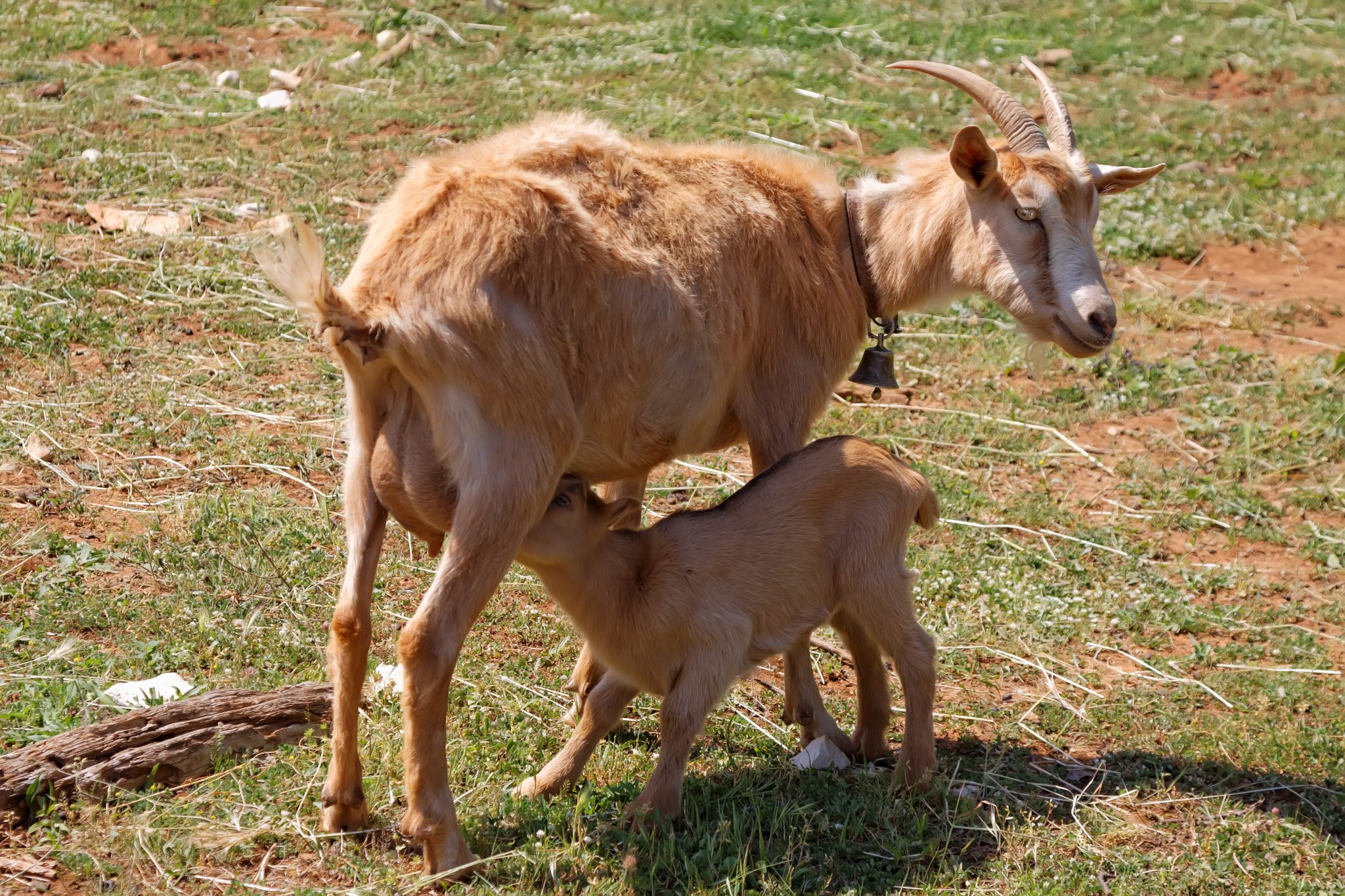Sheep & Goats

Producers can ensure the health of their herd by learning the proper procedures for care of their goats during kidding and in the days that follow.
To ensure bonding of does with their kids and to prevent hypothermia in newborn goat kids, maintain does that are expected to give birth within a few days in clean and dry stalls. Be familiar with the signs of impending parturition and know what to do when labor does not progress normally. Only experienced individuals should provide initial assistance with difficult deliveries. Having contact information for and a good working relationship with a local veterinarian is important for every goat farm. The veterinarian must be contacted promptly if the delivery does not progress adequately.
Typically, kidding occurs within one hour and should be rapid once fetal parts are visible. Cleanliness is of utmost importance when assisting with a delivery. Thoroughly wash hands and forearms before putting on exam gloves or obstetric sleeves.
Before an obstetric exam, thoroughly clean the area around the vulva of the goat with iodine scrub and water. Many causes of infectious abortions are zoonotic (can cause disease in people), so wear personal protective equipment (disposable gloves, coveralls) when handling cases of abortions. Pregnant women should never handle fetuses, bodily fluids, or other materials from does that are suspected to be aborting.
Care of Newborn and Nursing Goat Kids
Upon delivery, immediately assess newborn kids for vigor and presence of respiratory movements. Place kids that are active with the doe; however, if a kid appears dull and lifeless, remove any mucous from the nose and mouth with a piece of straw, a twig, or a finger. Do not swing or suspend kids by the hind limbs for extended periods of time, but rather place them in a sitting-up position to allow optimal oxygen flow to the lungs. Kids that do not start breathing rhythmically should be vigorously rubbed with straw or towels. You can also stimulate breathing by inserting a piece of straw or twig into the nose.
Inspect the umbilical (navel) remnants for bleeding and tie off only if you observe excessive bleeding. While a common recommendation has been to dip the navel in strong disinfectants such as a 7-percent iodine solution, this practice can cause inflammation and delayed healing of the umbilical remnants. Some producers may choose to use mild disinfecting solutions (dilute betadine or chlorhexidine solutions); however, a clean birthing environment and adequate colostrum intake are much more effective in preventing umbilical infections.
The most important health management procedure for newborn goat kids is to ensure intake of adequate amounts of good-quality colostrum. Healthy goat kids typically nurse the doe within 30 minutes, and producers should ensure colostrum intake within 2 hours of birth. After 12 hours of life, very few maternal antibodies are absorbed in the digestive tract, resulting in failure of passive transfer (FPT). Remember the 3 Q’s of colostrum—quality, quantity, and quickly. The quality of colostrum depends on production in the udder and collection from the doe. Does that leak “milk” before parturition or does that produce very large quantities of milk have lower concentrations of antibodies in their colostrum. Colostrum quality also decreases when colostrum is not milked out soon after parturition. The recommended quantity of colostrum that should be given to goat kids is at least 10 percent of the birth weight (example, for a kid that weighs 5 pounds, give at least 0.5 pounds = 0.5 pints of colostrum). Give this quantity quickly; a general rule of thumb is to give at least half of the total amount within 2 hours of birth and the second half within 6 hours of birth.

To prevent spread of infectious diseases, such as caprine arthritis encephalitis (CAE), Johne’s disease,
or Mycoplasma bacteria, do not mix (pool) colostrum from different does. Feed pooled colostrum only if it was previously pasteurized (56 degrees C or 130 degrees F for 60 minutes in water bath). If adequate quantities of colostrum are not available, plan to use commercially available colostrum replacers. Prevention of passive transfer is possible only with colostrum replacers, but not with colostrum supplements. Furthermore, colostrum replacers should be those made from bovine colostrum rather than from serum (bovine serum globulins).
Perform dehorning (disbudding) procedures as early as possible in life. Electric or butane-heated dehorning instruments are safer than dehorning pastes. But be careful to avoid applying excessive heat to the skull, which can lead to severe brain damage.
Many producers prefer to castrate male kids early in life, often by placing a rubber band (elastrator band) on the scrotum. This practice can result in two potential health problems, tetanus and urolithiasis (obstruction of the urinary tract with urinary stones). Prevention of tetanus, a commonly fatal clostridial disease, is critical in any animal in which castration using a rubber band is undertaken and should be considered fundamental for all small ruminant operations. The best prevention in nursing kids is to ensure that the dam’s colostrum contains an adequate amount of antibodies against tetanus toxins, which can be achieved by routinely vaccinating dams with CD/T or tetanus toxoid, including a booster within 1 month before giving birth.
Urolithiasis is most common in male castrated goats that are fed a concentrate-rich diet, including pet goats and those fattened for harvest. Producers should consider delaying castrating goats that are expected to consume large amounts of grain until puberty. Proper castration techniques, including pain control, must be discussed with a veterinarian if castration is performed later in life.
Care of Weaned Goat Kids
While weaning procedures and the time of weaning vary among operations, necessary health management procedures and observed health problems are similar among farms. The stress of weaning, transition from a milk-based diet to forage and concentrate, and housing of weaned goats in a new environment result in reduced function of the immune system and contribute to common health problems. Parasitism and respiratory disease are most common in young, weaned goat kids until approximately one year of age.
Coccidiosis (clinical disease associated with protozoal organisms of the genus Eimeria) results from overcrowding, accumulation of feces in the environment, and inadequate immune responses and is, therefore, most common in weaned kids that are group-housed in stalls or paddocks. Coccidiosis can be prevented by provision of a good quality, protein-rich diet, avoidance of overcrowding (less fecal accumulation occurs in pastures than in stalls or paddocks), and cleanliness of the environment. Medications that help prevent coccidiosis (coccidiostats) are commercially available for use in feed or mineral supplements. When clinical signs of coccidiosis, including diarrhea, weight loss, or straining to defecate are noticed, contact a veterinarian to advise treatment because effective medications for the treatment of coccidiosis are not labeled for use in goats.
To achieve the genetic potential of future milking does and breeding bucks, nutrition of young goats must be formulated to achieve appropriate growth rates and adequate immune responses, while preventing overconditioning, which results in deposition of fat in the developing udder and reproductive tract. As for adult goats, young goats require good quality forage that is supplemented with concentrate feeds and minerals.
Commonly, first vaccinations are given at weaning time with boosters administered as per manufacture recommendation. Develop with a veterinarian a proper vaccination protocol to address specific health concerns that vary among herds.
Control of Intestinal Worms
Successful control of intestinal worms (especially Haemonchus contortus, the barber pole worm) cannot solely rely on medications. For detailed information on control of intestinal nematodes, seek detailed information from your veterinarian or other knowledgable source. Unfortunately, parasites on most small ruminant farms in the southeastern United States are resistant against one or multiple types of dewormers, and control of parasites must be based on sound management practices, including the following:
- Improvement of housing and pasture
- Provision of browse and high-quality feeds
- Implementation of rotational grazing
- Feeding in elevated feed bunks and hay racks
- Assessment of parasite burden in herd
- Routine fecal flotation
- Egg-count quantification by McMaster’s technique
- Assessment of anemia with FAMACHA program
- Identification of anthelmintic resistance
- McMaster fecal egg count on fecal samples before and 7 to 10 days after deworming
- Deworming resulting in more than 90 percent reduction in egg count
- DrenchRite assay
- Cultures parasites in vitro, similar to bacterial sensitivity testing
- McMaster fecal egg count on fecal samples before and 7 to 10 days after deworming
- Removal of highly infested shedders and genetic selection of small ruminants inherently resistant to parasites
- Appropriate deworming of only those animals that need it
- Biosecurity to keep animals with resistant parasites off the farm
- Alternative control methods
- Copper oxide particles
- Cograzing or sequential grazing of different livestock species
- High tannin-containing forages such as Sericea lespedeza
Download a PDF of Care During & Post Kidding In Dairy Goats, ANR-2490.

